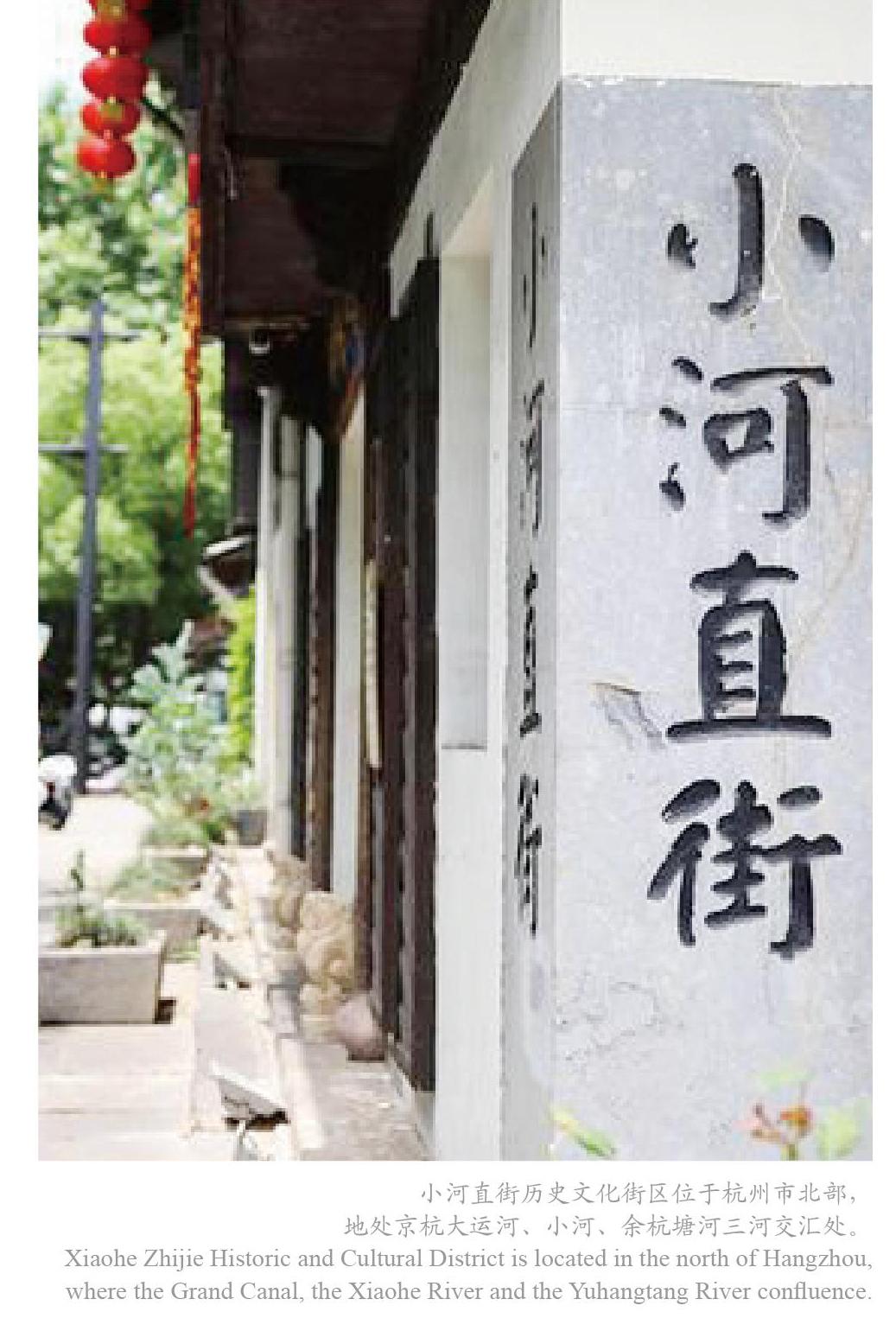遗产风物生生不息
2021-10-21金少策
金少策



悠悠运河水流淌两千多年,滋养着北京、天津、河北、山东、河南、安徽、江苏、浙江等8省市35座城市。大运河之上,富商巨贾文士名人尽显风流,江南丝竹民间曲艺精彩纷呈。2014年6月,作为世界上里程最长、最古老、工程最大的人工运河,中国大运河入选世界文化遗产名录。从河畔人家到数字小镇,从古桥渡口到文创街区,未变的是两岸亘古不灭的人间烟火,生生不息。
运河上“飘”来的北京城
“云光水色潞河秋,满径槐花感旧游。无恙蒲帆新雨后,一枝塔影认通州。”这是清代诗人王维珍的诗《古塔凌云》,诗中的塔指的就是燃灯塔。沿通州新华大街再向东就到了东关大桥,桥下就是北运河,燃灯佛舍利塔位于通州北端运河西岸,距今已有1300多年历史。
不久前,北运河通州段迎来全线旅游通航。从漕运码头出发,沿着全新的航道前行,不仅可以欣赏旖旎风光,还能感受大运河文化的魅力。行至甘棠船闸,“甘棠鱼跃”4个字跃然闸首,浮雕墙上复刻清朝乾隆年间绘制的《潞河督运图》,再现当年运河河道漕运经济、商贸往来及民俗文化盛景。
随船而行,大运河丰富的文化遗产和形态万千的民风民俗令人印象深刻。
大运河北京段纵贯千年、横跨七区,物质文化遗产和非物质文化遗产“虚实”结合。有横跨运河的古桥,有坐落在运河旁的古寺,有通州运河船工号子,还有与运河有关的胡同……
大运河滋养着北京,北京也呵护着这条河。老北京人常说“大运河漂来的北京城”,形象地说明了北京城与大运河密不可分的关系。历史上的大运河,不仅是供应北京漕粮的经济补给线,还是影响北京城市气质的文化交流线。
大运河在五大水系之间架起了一座文化沟通的桥梁,来自各地的文化荟萃于此,造就了海纳百川的北京文化,京味文化也由此流向四面八方。
作为北京面塑(中国民间传统的一种雕塑工艺品)重要代表的“面人汤”面塑,据说创始人汤子博的技艺就是向山东菏泽(曹州)的面塑艺人学的,而这位师傅正是经由运河来到通州谋生;漷县镇张庄村的通州运河龙灯会所舞的两条蛟龙代表“水”的蓝色,是运河文化的鲜明印记。
国粹京剧的出现也离不开这条文化水路。清朝乾隆年间,各地戏班齐聚扬州登台献艺。演出结束后,各戏班沿运河北上,每经过一个城镇,就拢船登岸,就地搭台演出,走一路演一路。一路上不同的戏曲班子同台演出,互相借鉴。1782年,这支荟萃了不同地方戏曲品种的队伍到达北京。1790年,“四大徽班”沿运河入京,经过几十年发展,京剧诞生。就像用水和面一样,大运河把各个曲种融合在一起。
“漕运昼夜不停,运河号子连天。”这是当年通州大运河鼎盛时期的景象。随着“运河断航,船工转行”,胜景不再,令人惋惜。如今,通州大运河上最后一位老船工、北运河船工号子唯一的非遗传承人赵庆福老人虽已去世,但通州运河号子并没有因此而成绝唱。
通州是京杭大运河的北起点,大运河文化的重要节点,当地人对大运河有着深厚的情感,很多老百姓都能讲出一段段运河故事。
当年,运河繁忙之时,桥下驳船排列前行,桥上人流穿梭,好不热闹。著名的通州八景之一“长桥映月”,就位于此处,“入夜霜清一轮坠,凌寒征铎去萧萧”,便是此景最生动的写照。
千年运河孕育了银湖墅
运河穿杭州而过,那延绵数千年的京杭大运河,宛如杭城永不干竭的血脉,促成了这座城市的活力与繁荣。
在京杭大运河南端终点标志——拱宸桥的东侧、杭州拱墅区运河文化广场的南侧,坐落着一座讲述京杭大运河数千年风雨传奇的专题博物馆——京杭大运河博物馆。它一方面是一个全方位、多角度反映和展现运河自然特性、人文精华等各个方面的大型博物馆,另一方面又是运河文物、文献资料等的征集、收藏中心和运河文化的研究和展示中心。它犹如一架“时空穿梭机”,让进入馆内的每一个游客都能穿越回各个时代,瞥一眼运河的历史身影,了解运河的前世今生。
按序进入馆内,首先映入眼帘的便是一艘古朴沧桑的漕运船。这便是博物馆的起点——序厅。亮点即在于这一艘摆于正中的漕运船,以及头顶设计成灿烂星空的天花板与脚下以玻璃钢铺设而成的仿真水面,给人一种在运河上徜徉而行、且行且仰望星空的感觉。
京杭大运河博物馆共分为“运河的开凿与变迁”“大运河的功用”“大运河浙江段专题陈列馆”“运河文化”四个展厅,从各个层面集中呈现了大运河的历史、文化与价值。馆内陈列之丰富,非一笔所能说尽。
参观了第三展厅“大运河浙江段专题陈列馆”以及第四展厅“运河文化”之后,你心中最深的感想一定是这样:杭州的发展与演变,绝对离不开大运河的影响。不管是拥有“江南运河第一桥”美誉的拱宸桥,还是“小河贯万家,街区竞物华”的小河直街,还是“北有南新仓,南有富义仓”的富义仓,还是“香火头道门”的香积寺……都是大运河在杭州留下的深刻印记。
尤其是拱宸桥,就在京杭大运河博物馆西面数十米处,走几步就到。踏上这座沧桑而又坚固如新的古桥,从博物馆中所获知的运河知识,完美地融入到了实物之中,“游与学”在这里成为简单而愉快的一件事情。
这座建于明崇祯四年(1631)的石拱桥,作为京杭大运河的南端终点所在,不仅养育了一方水土,还曾经形成了一个繁荣的商业区域——“十里银湖墅”,人烟阜盛,商贾云集。此外,这一带还形成了有名的“北关夜市”,同样热闹非凡。
运河沿岸尽显古迹之美
千年运河肇始于江苏,大运河江苏段多元化特征明显,具有遗产类型多样、数量丰富的特点。其中,列入世界遗产名录的遗产区核心面积约占全国一半、遗产河段长度约占全国三分之、遗产点数量约占全国40%。
扬州,中国大运河的发轫地,有着“运河长子”的美誉。今年6月16日,中国大运河博物馆开馆,一票难求。
坐落于扬州运河三湾生态文化公园内的中国大运河博物馆,是一座全流域、全时段、全方位展示大运河世界文化遗产价值,以及大运河带來美好生活的专题博物馆。馆内,有桥有塔,登塔可俯瞰“三湾抵一坝”的历史景观,现有春秋至当代反映运河主题的古籍文献、书画、碑刻、陶瓷器、金属器等各类文物展品1万多件(套)。
馆藏有搬自河南开封附近一段长25.7米、高8米的老汴河剖面,也有整体取自镇江的唐代船型墓葬,大到来自宜兴市的南宋馒头窑,小到洛阳市文物考古研究院送抵的炭化粟米……博物馆堪称中国大运河的“百科全书”,是江苏大运河国家文化公园建设中最有分量的一块“金字招牌”。
如今,从徐州的窑湾镇历史街区到淮安清晏园,从扬州瘦西湖到镇江西津渡古街、从无锡清名桥历史街区到苏州盘门等……一街一镇、一湖一景,都在围绕遗产点打造国家文化公园建设,一幅古今辉映、人水共生的最美画卷正在运河沿线徐徐铺展。
大运河安徽段沟通融汇中原、淮扬、齐鲁、楚汉等地域文化,安徽段全长180公里,其中,有水河段约47公里,无水河段约133公里,自河南商丘流入安徽淮北、宿州,进入江苏宿迁,是隋唐大运河承上启下、连通东西,贯穿黄河、淮河两大水系的重要河段之一。
大运河“枢纽天下,临制四海,舳舻相会,赡给公私”,到南宋末年因淤塞严重而几近断流。大运河安徽段“扼汴河咽喉,当南北要冲”,属隋唐大运河通济渠,是中原文化高地的重要组成部分。
遗产点柳孜运河遗址位于安徽淮北,出土宋代河堤、虹桥遗址、木岸狭河、金代驿道等重要遗迹,是隋唐大运河水工设施遗址的首次发现。通济渠泗县段是隋唐大运河现存不多的活态遗址,也是保存最完好、内涵最丰富的河段之一,已成为研究隋唐大运河的重要“活化石”。
大运河遗产山东段,被山东人民亲切地誉为“山东的莱茵河”,全长643公里,由北至南依次经过德州、聊城、泰安、济宁和枣庄5市。山东申遗点段包括南运河德州段、会通河临清段、会通河阳谷段、会通河南旺枢纽段、小汶河、会通河微山段、中河台儿庄段等8段运河15处遗产点,总长186公里,遗产区暨文物本体保护区面积为16603公顷,是大运河整体申遗最有力的支撑点段之一。它们历经元明清三代的开挖与修葺,留存了大量的文物古跡。
大运河遗产名录
北京市:河道2段,遗产点4个
河道2段:通惠河北京旧城段、通惠河通州段
遗产点4个:玉河故道、澄清上闸(万宁桥)、澄清下闸(东不压桥)、什刹海
天津市:河道1段
河道1段:天津三岔口(北、南运河及海河交汇处)
河北省:河道1段,遗产点2个
河道1段:南运河沧州至德州段
遗产点2个:沧州东光连镇谢家坝、衡水景县华家口夯土坝
山东省:河道6段,遗产点14个
河道6段:南运河德州段、会通河临清段、会通河阳谷段、南旺水利枢纽、会通河微山段、中运河台儿庄段
遗产点14个:临清运河钞关、阳谷古闸群(荆门上闸、荆门下闸、阿城上闸、阿城下闸)、东平戴村坝、汶上邢通斗门遗址、汶上徐建口斗门遗址、汶上十里闸、汶上柳林闸、汶上寺前铺闸、南旺分水龙王庙遗址、汶上运河砖砌河堤、微山县利建闸
河南省:河道4段,相关遗存3个
河道4段:通济渠郑州段、通济渠商丘南关段、通济渠商丘夏邑段、永济渠(卫运河)滑县浚县段
相关遗存3个:洛阳含嘉仓遗址、洛阳回洛仓遗址、浚县黎阳仓遗址
安徽省:河道1段,相关遗存1个,遗产点1个
河道1段:通济渠泗县段
相关遗存1个:柳孜运河遗址
遗产点1个:柳孜桥梁遗址
江苏省:河道6段,相关遗存1个,遗产点21个
河道6段:中运河宿迁段、淮阳运河淮安段、淮阳运河扬州段、江南运河常州城区段、江南运河无锡城区段、江南运河苏州城区段
相关遗存1个:总督漕运公署遗址
遗产点21个:宿迁龙王庙行宫、清口水利枢纽、淮安双金闸、淮安清江大闸、淮安洪泽湖大堤、宝应刘堡减水闸、高邮盂城驿、江都邵伯古堤、江都邵伯码头、扬州瘦西湖、扬州天宁寺行宫和重宁寺、扬州个园、扬州汪氏小苑、扬州盐宗庙、扬州卢绍绪宅、无锡清名桥历史文化街区、苏州盘门、苏州宝带桥、苏州山塘历史文化街区、苏州平江历史文化街区、吴江运河古纤道
浙江省:河道6段,遗产点13个
河道6段:江南运河南浔段、江南运河嘉兴至杭州段、浙东运河萧山至绍兴段、浙东运河上虞至余姚段、浙东运河宁波段、宁波三江口
遗产点13个:南浔古镇、嘉兴长虹桥、嘉兴长安闸、杭州富义仓、杭州凤山水城门遗址、杭州桥西历史街区、杭州拱宸桥、杭州广济桥、西兴过塘行码头、绍兴八字桥、绍兴八字桥历史街区、绍兴古纤道、宁波庆安会馆
Heritage and Scenery: All the More Lively
By Jin Shaoce
Flowing for over 2,000 years, the Grand Canal has been nourishing the eight provinces and municipalities, as well as the 35 cities it passes through. In June 2014, as the longest, oldest and largest man-made artificial river in the world, it was listed as a UNESCO World Cultural Heritage site. From riverside homes to digital towns, from ancient docks to cultural and creative communities, what has not changed over time is the people on both banks of the river.
Along the Beijing section of the Grand Canal, which spans seven districts for thousands of years, visitors will be able to see ancient bridges striding the canal, ancient temples and pagodas on the banks of the canal, ancient hutongs (small alleys) related to the canal, and listen to the traditional chanting of boatmen on the west bank of the Tongzhou canal...
Not long ago, the Tongzhou section of the Bei (North) Canal in Beijings Tongzhou district was officially opened for tourism navigation. Starting from the Caoyun Dock, travelers can not only enjoy the beautiful scenery, but also feel the charm of the Grand Canal culture.
Indeed, as a bridge of cultural communication between the five major water systems of the Haihe River, the Yellow River, the Huaihe River, the Yangtze River and the Qiantang River, where cultures from all around the nation converge, it is the Grand Canal that has helped created the unique Beijing culture, and that has helped the Beijing culture flow to all directions.
For example, Master Tang Zibo, founding father of Flour Figure Tang, a dough figurine brand created during the Qing dynasty, is said to have learned the craft from a Shandong craftsman who journeyed to Tongzhou via the Grand Canal seeking livelihood opportunities. The Peking Opera, that quintessence of Chinese culture, could also trace its origins to the various performing troupes traveling along the Grand Canal.
At its southern end, the Grand Canal is running through the city of Hangzhou like an artery, providing inexhaustible sources of vitality, strength and prosperity.
On the southern side of the Canal Culture Square in the citys Gongshu district, at the east of Gongchen Bridge, which marks the southern end of the Grand Canal, lies the Grand Jing-Hang Canal Museum. On the one hand, it is a museum that shows the natural characteristics and cultural essence of the Grand Canal in various perspectives; on the other hand, it is also a collection center of cultural relics and documents on the Grand Canal, as well as a research and exhibition center showcasing the canals culture. Like a “time and space machine”, the museum enables every visitor to travel back in time to different periods and learn the history of the canal.
Entering the museum, the first thing visitors see is an ancient and battered Caoyun (tribute grain transport) boat, placed right in the middle of the hall, the starting point of the museum. More notable is that right above the boat, the ceiling is designed to resemble a sky full of stars, and the simulated water surface laid with steel glass underneath lend visitors a feeling of flowing on the canal under the starry sky.
The Grand Jing-Hang Canal Museum is divided into four exhibition halls, including the “Digging and Transformation of the Grand Canal”, the Functions of the Grand Canal”, the “Special Exhibition of the Zhejiang Section of the Grand Canal” and the “Canal Culture”, presenting the history, culture and value of the Grand Canal from all kinds of angles. Indeed, the richness of the exhibitions cant simply be described in a few words.
After visiting the “Special Exhibition of the Zhejiang Section of the Grand Canal” and the “Canal Culture”, most visitors may well conclude: the development of Hangzhou is inseparable from the Grand Canal. The Gongchen Bridge, the Xiaohe Zhijie Historical and Cultural District, the Fuyi Granary or the Xiangji Temple…each of these distinctive Hangzhou symbols came directly from the Grand Canal.
The Gongchen Bridge, in particular, which is only a dozen meters west of the museum, well within the walking distance. Stepping on this ancient and sturdy bridge, the knowledge of the canal gleaned from the museum is perfectly integrated into the “real thing”. Built in the fourth year (1631) during the reign of Emperor Chongzhen of the Ming dynasty (1368-1644), the Gongchen Bridge, a stone arch bridge, is not only the southern terminus of the Jing-Hang Grand Canal, but also was the heart of a bustling commercial center, which was densely populated and crowded with merchants. In addition, the surrounding area used to house the famous “Beiguan night market”, which was equally boisterous.
“Born” in Jiangsu province, it is only natural that the Jiangsu section of the Grand Canal is one of the most diversified in terms of the number and the type of heritage sites. The area of heritage sites inscribed in the World Heritage List accounts for about half of the nations total, the number of heritage sites for about 40% of the nations total, and roughly one-third of the Grand Canal lies in Jiangsu province.
As the birthplace of the Grand Canal, Yangzhou is reputed as “the oldest son of the canal”. When the China Grand Canal Museum opened in the city on June 16, 2021, tickets were immediately sold out. Located in Yangzhou Sanwan Ecological and Cultural Park, the museum is the first modern comprehensive canal theme museum in China that integrates cultural relics protection, scientific research exhibitions and social education. More than 10,000 cultural relics about the canal from the Spring and Autumn Period to the present, such as ancient books, calligraphies and paintings, inscriptions, ceramics, metal ware and so on, are on display.
From a 25.7-meter-long, 8-meter-high cross-section map of the old Bianhe River near Kaifeng city, Henan province, to carbonized millet grains…visitors are supplied with almost all the artefacts on the Grand Canal. The museum is rightly called an “encyclopedia” of the canal, and it is the most important part in Jiangsus efforts to build a Grand Canal National Cultural Park.
With a length of 180 kilometers, the Anhui section of the Grand Canal connects the Central Plains, the Huaiyang region, the Qilu region, the Chuhan region, among other historical and regional cultures. At present, about 133 kilometers of the Anhui section are dry while 47 kilometers are still navigable. Joining Shangqiu in Henan province in the upper reaches and Suqian in Jiangsu province in the lower reaches, the Anhui section was a major part of the Sui-Tang Grand Canal — a part of the Tongji Canal, to be more precise — that helped link the east with the west and that cut through the Yellow River and the Huaihe River.
The Shandong section of the Grand Canal is affectionately called the “Rhine of Shandong” by local people. With a total of 643 kilometers, this section passes through the cities of Dezhou, Liaocheng, Taian, Jining and Zaozhuang from north to south. During the bid for the Grand Canal to become a World Heritage Site, eight canal sections running for 186 kilometers and 15 heritage sites were included. The area that these sections and heritage sites have covered is measured at 16,603 hectares, one of the most significant contributing factors to the Grand Canals successful addition to the World Heritage List.
Inscribed Heritage Items of the Grand Canal
Beijing Municipality: 2 Canal Sections, 4 Heritage Sites
2 Canal Sections: Old Beijing City of the Tonghui Canal, Tongzhou section of the Tonghui Canal)
4 Heritage Sites: Former Canal of Yuhe River, Upper Lock of Chengqing, Lower Lock of Chengqing, Shicha Lake
Tianjing Municipality: 1 Canal Section
1 Canal Section: Tianjin Shanchahou (estuary of Bei Canal, Nan Canal and Haihe River)
Hebei Province: 1 Canal Section, 2 Heritage Sites
1 Canal Section: Cangzhou-Dezhou section of the Nan Canal
2 Heritage Sites: Xiejia Dam in Cangzhou, the well-preserved rammed-earth levée of Huajiakou in Hengshui County
Shandong Province: 6 Canal Sections, 14 Heritage Sites
6 Canal Sections: Dezhou section of the Nan Canal, Linqing section of the Huitong Canal, Yanggu section of the Huitong Canal, Nanwang Complex, Weishan section of the Huitong Canal, Taierzhuang section of the Zhong Canal
14 Heritage Sites: Linqing Customs Post, Yanggu Complex (Upper Lock of Jingmen, Lower Lock of Jingmen, Upper Lock of Echeng, Lower Lock of Echeng), Daicun Dam in Dongping County, Archeological Site of Wenshang Xingtong, Archeological Site of Wenshang Xujiankou Lock, Archeological Site of Wenshang Shili Lock, Archeological Site of Wenshang Liulin Lock, Archeological Site of Wenshang Siqianpu Lock, Archaeological Site of Nanwang Royal Dragon Temple, Archaeological Remains of Wenshang Brick Dyke, Remains of the Lijian Lock in Weishan County
Henan Province: 4 Canal Sections, 3 Archeological Sites
4 Canal Sections: Zhengzhou section of the Tongji Canal, Shangqiu Nanguan section of the Tongji Canal, Shangqiu Xiayi section of the Tongji Canal, Hua-Xun section of the Yongji Canal (or Wei Canal):
3 Archeological Sites: Archaeological Site of the Hanjia Granary, Archaeological Site of the Huiluo Granary, Archaeological Site of the Liyang Granary
Anhui Province: 1 Canal Section, 1 Archeological Site, 1 Heritage Site
1 Canal Section: Si section of the Tongji Canal
1 Archeological Site: Archaeological Site of Liuzi Canal
1 Heritage Site: Archaeological Site of Liuzi Bridge
Jiangsu Province: 6 Canal Sections, 1 Archeological Site, 21 Heritage Sites
6 Canal Sections: Suqian section of the Zhong Canal, Huaian section of the Huaiyang Canal, Yangzhou section of the Huaiyang Canal, Changzhou City section of the Jiangnan Canal, Wuxi City section of the Jiangnan Canal, Suzhou City section of the Jiangnan Canal
1 Archeological Site: Archeological Site of the Caoyun Governors Mansion
21 Heritage Sites: Royal Dragon Temple and Palace in Suqian, Qingkou Hydraulic Complex, Shuangjin Boat Lock in Huaian, Qingjiang Boat Lock in Huaian, Hongze Lake Stone Dyke, Archaeological Site of Luibao Drainage Lock, Yuchen Post in Gaoyou, Remains of the Ancient Shaobo Dyke, Shaobo Docks, Slender West Lake in Yangzhou, Tianning Palace and Temple in Yangzhou, Ge Garden in Yangzhou, Wang Lumens Residence in Yangzhou, Salt Ancestral Temple in Yangzhou, Lu Shaoxus Residence in Yangzhou, Historic Qingming Bridge Quarter in Wuxi, Pan Gate in Suzhou, Shantang Canal Conservation Zone in Suzhou, Historic Pingjiang Quarter in Suzhou, Former Wujiang Towpath in Suzhou
Zhejiang Province: 6 Canal Sections, 13 Heritage Sites
6 Canal Sections: Nanxun section of the Jiangnan Canal, Jiaxing-Hangzhou section of the Jiangnan Canal, Xiaoshan-Shaoxing section of the Eastern Zhejiang Canal, Shangyu-Yuyao section of the Eastern Zhejiang Canal, Ningbo section of Eastern Zhejiang Canal, Ningbo Sanjiangkou
13 Heritage Sites: Nanxun Ancient Town, Changhong Bridge in Jiaxing, Changan Lock in Jaixing, Fuyi Granary in Hangzhou, Archeological Site of Fengshan Hydraulic Gate, Qiaoxi Conservation Area in Hangzhou, Gongchen Bridge in Hangzhou, Guangji Bridge in Hangzhou, Docks of Xixing Distribution Center, Bazi Bridge in Shaoxing, Bazi Bridge Historic Block in Shaoxing, Ancient Towpath in Shaoxing, Qingan Guildhall in Ningbo
